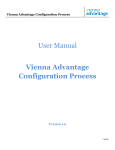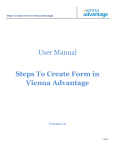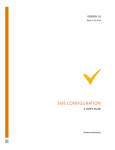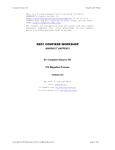Download User Manual - The UK Mirror Service
Transcript
VIENNA Advantage Silverlight Technical Document
User Manual
VIENNA Advantage Silverlight Technical Document
Version 1.0
1 of 31
VIENNA Advantage Silverlight Technical Document
Table of Contents
1.
INTRODUCTION ..................................................................................................................................................... 3
2.
CODE STRUCTURE .................................................................................................................................................. 4
3.
MODULE CREATION ............................................................................................................................................... 5
3.1
MODULE PREFIX ................................................................................................................................................ 5
3.2
HOW TO USE PREFIX .......................................................................................................................................... 6
3.3
RENAME ASSEMBLY ........................................................................................................................................... 7
3.4
ENTRIES IN MODULE MANAGEMENT WINDOW................................................................................................. 8
3.5
LOADING ASSEMBLY .......................................................................................................................................... 9
4.
CONCEPT OF X-CLASS AND M-CLASS ...................................................................................................................... 9
4.1
HOW TO MAKE X-CLASS................................................................................................................................... 11
4.2
HOW TO MAKE M-CLASS ................................................................................................................................. 13
4.3
PO-CLASS AND DATA FLOW IN CLASSES ........................................................................................................... 16
5.
CALLOUT .............................................................................................................................................................. 17
5.1
WRITING A CALLOUT ....................................................................................................................................... 17
5.2
METHODS USE IN CALLOUT ............................................................................................................................. 20
5.3
BIND CALLOUT TO COLUMN ............................................................................................................................ 21
5.4
TESTING THE CALLOUT ..................................................................................................................................... 22
6.
PROCESS .............................................................................................................................................................. 23
6.1
WHAT IS PROCESS............................................................................................................................................ 23
6.2
EXAMPLE OF A PROCESS CLASS ....................................................................................................................... 24
6.3
DEFINING A PROCESS ....................................................................................................................................... 25
6.3.1
PARAMETER TAB ............................................................................................................................................. 28
6.4
BINDING OF PROCESS ...................................................................................................................................... 29
6.5
PROCESS ACCESS ............................................................................................................................................. 30
2 of 31
VIENNA Advantage Silverlight Technical Document
1.
Introduction
VIENNA Advantage is an open source ERP, developed in dot net technology with visual studio 2010 as IDE
(Integrated Development Environment). The Application is in Silverlight, source code of which is available at
following link:
https://viennaadvantage.codeplex.com/
After downloaded source code, open it in visual studio 2010. You will see the following structure
There are six projects in the solution.
VAdvantage: It is a Client Side project, which is the part of our base product. The code under this project will
run on client side and its dll will reside in Xap file of hosting project.
VAdvantageSvc: It is a Server Side project, which is the part of our base product. The code under this project
will run on server side and dll related to this project will reside in bin folder of hosting project. This project
contains WCF Service related classes and reference of core project Model Library dll.
ModelLibrary: It is a Core Server Side library, which is the part of our base product. Which contain all the
business logic Model classes, Callout classes, Process classes etc. Each class is reside in proper structure
inside the ModelLibrary Project. Now the dll of this library is run on server side so this dll is refer in product
server side project VAdvantageSvc.
All the above three projects are related to core product.
Further there are two more projects
ViennaAdvantage and VennaAdvantageSvc
The basic concept behind providing these two project is to make your own Module base on the core product.
ViennaAdvantage: It is a Module Client Side project for Module Creation, the code under this project run on
client side and it contains the reference of core product VAdvantage project dll.
3 of 31
VIENNA Advantage Silverlight Technical Document
ViennnAdvatangeSvc: It is a Module Server side project, the code under this project run on the server side
and it also contains the reference of core product Model Library dll.
One hosting project named ViennaAdvantageWeb
ViennaAdvatnageWeb: It is the hosting project that finally deploy for hosting in the IIS, which contain
reference of all client side Xap and server side dlls.
2.
Code Structure
Code structure of Product Project
Model Library Project
VAdvantage Project
Model Folder: Model Folder contains all business logic Module classes (MClasses) related to Application
Dictionary Database Table. If developer doesn't create MClass for a particular database table then data is
save directly into database via PO class.
Model Folder will exist in both projects, server side project and client side project.
4 of 31
VIENNA Advantage Silverlight Technical Document
Model/Callout Folder: Contains all callout classes, which will used for custom logic like on selection of one
field populates other fields on the current window tab. Also custom logic for validating user input on the
field.
Process Folder: Process Folder contains all process logic classes such as consolidate a number of orders to a
single shipment document, copying document, generate invoice on reference button click or on click menu
item. Process folder also contains the code for running the third party tool process such as running report.
Process will run on sever side so it will be the part of Model library project.
Working with files
Basically you can work in two ways in the solution. One way is that you can add, modify source code of core
product itself. Update existing MClasses, Process classes or callout classes OR you can add your MClasses,
Process class in the related folder according to your requirement.
Second way is that you work in module specific project in ViennaAdvantage and ViennaAdvantageSvc.
Create your own MClasses, XClasses, Callout classes and put in module specific project and keep the same
structure as provided in the product projects. Like keep your MClasses and XClasses in Model Folder on client
side and server side. Keep your process classes in Process Folder in ViennaAdvatnageSvc, because process
runs on server side.
The benefit of module over directly work in product files is that latter on you can download Module from the
Vienna Market. Second, if you directly update product files and host the application with your custom update
product dll and later on if you update Vienna Advantage from the Vienna Market then it will replace the
product specific dll and your extended work will be lost. But if you work in your specific module then dll
related to your module will never update. It will only update if you download your specific module.
3.
Module Creation
3.1
Module Prefix
Prefix is the base for any Module in Vienna. At present there are Modules available in the Market and all with
the unique prefixes. To name few of them like VACTWZ_ , VAHRUAE_ etc.
For development of any module first step is to get module prefix name from VIENNA. You can also choose your
prefix name and send to us so that Vienna will reserve that prefix for your module and will not allocate that
name to any other module. Prefix is uniquely define a module separate from other modules.
5 of 31
VIENNA Advantage Silverlight Technical Document
3.2
How to use Prefix
Whenever you create new database table, column, window etc. use module prefix. Suppose you are going to
create Accounting Application and its prefix like ACTAPP. Then use prefix + “_” with every table, column,
window etc. E.g if table name is TaxMaster then while create table in Vienna Advantage table name is
ACTAPP_TaxMaster.
Note: a) Module prefix name should not be less than three character.
b) Prefix should be unique for every module.
Now after finalize the prefix name, it is mandatory that you use this prefix name in table, column and window
in Application Dictionary.
Here is a list of Tables and respective windows where prefix is require:
Window Name
Table name
Column
Table and Column
AD_Table
DB Table Name
System Element
AD_Element
DB Column Name
Table and Column
AD_Column
DB Column Name
Message
AD_Message
Value
Value
AD_Reference
Name
Window, Tab &
Field
Report & Process
AD_Window
Name
AD_Process
Name
Form
AD_Form
Name
Shortcut
Print Format
Report Format
Workflow
Validation Rules
AD_Shortcut
AD_PrintFormat
AD_ReportFormat
AD_Workflow
AD_Val_Rule
Name
Name
Name
Name
Name
Value
Value
Descripion
On creating table use prefix name +
“_” for DB Table Name. for example if
table name is ‘TaxMaster’. Then after
use prefix it become ‘
ACTAPP_TaxMaster’. ACTAPP is
prefix unique code
On creating system element use prefix
name + “_” for DB Column Name like
column name is Description then it
become ACTAPP_Description.
On creating column use prefix name +
“_” for DB Column Name
On creating message use prefix + “_”
for Value field
On creating reference use prefix + “_”
for name field
On creating window, use prefix + “_”
for window name
Use prefix + “_” for name and value
filed in window Report & Process
Use prefix + “_” for Name field in F
Form window
Use prefix + “_” for Shortcut name
Use prefix + “_” for name
User prefix + “_” for name
Use prefix + “_” for Name and Value
Use prefix + “_” for Name
6 of 31
VIENNA Advantage Silverlight Technical Document
3.3
Rename Assembly
Client Side Assembly
To run your module, rename the assembly of client side project (ViennaAdvantage) with the module prefix
name. For this right click on the project go to properties and change Assembly Name as show in below pic
Like if Module prefix name is ‘ACTAPP’ then Assemble name should be ACTAPP.
Server Side Assembly
Rename Assembly of Server Side Project ‘ViennaAdvantageSvc’ with Module Prefix Name + “Svc”. As show in
below pic
So in this case Assemble name is ‘ACTAPPSvc’.
7 of 31
VIENNA Advantage Silverlight Technical Document
3.4
Entries in Module Management Window
To run your module in the system you must insert module information in Module Management window.
After login in the application with Role ‘System Administration’.
Open the window-> Module Management
First Tab of this Window is regarding Module related info
Field Name
Module
Description
Version No
Assembly Name
Unique Prefix
Namespace
Description
Enter your module name
Enter your module description
Enter your module version number
Enter your assembly name (Assemble should be
created with the same name of prefix),
Enter your prefix name + “_” (only one underscore
after prefix name)
Enter namespace by default it is ViennaAdvantage.
But if you change it then insert accordingly
8 of 31
VIENNA Advantage Silverlight Technical Document
All the fields mentioned above are required to identify the module by system at runtime.
3.5
Loading Assembly
System will load module assemblies which are defined in the module management window and will execute
M Classes, X Classess, Callout Classes etc according to assembly.
4.
Concept of X-Class and M-Class
Purpose of X Classes is to provide getter and setter method to Model classes. X Classes are the properties
classes, which are based on a database tables. Whenever you change the fields of a table you need to update
its X class.
M Classes are used to write business logic and it extends X Classes for getter and setter method. If a tab of
window using a workflow processes with node have Document Action functionality then M Class should
implements DocAction class.
With the help of X-Classes and M Classes, business logic for the window will be created.
Following is an example of an X-Class :
9 of 31
VIENNA Advantage Silverlight Technical Document
namespace ViennaAdvantage.Model
{
/** Generated Model - DO NOT CHANGE */
using System;
using System.Text;
using VAdvantage.DataBase;
using VAdvantage.Common;
using VAdvantage.Classes;
using VAdvantage.Process;
using VAdvantage.Model;
using VAdvantage.Utility;
using System.Data;
/** Generated Model for C_InvoicePaySchedule
* @version Vienna Framework 1.1.1 - $Id$ */
publicclassX_C_InvoicePaySchedule : PO
{
public X_C_InvoicePaySchedule (Context ctx, int C_InvoicePaySchedule_ID, String trxName) :
base (ctx, C_InvoicePaySchedule_ID, trxName)
{
/** if (C_InvoicePaySchedule_ID == 0)
{
SetC_InvoicePaySchedule_ID (0);
SetC_Invoice_ID (0);
SetDiscountAmt (0.0);
SetDiscountDate (DateTime.Now);
SetDueAmt (0.0);
SetDueDate (DateTime.Now);
SetIsValid (false);
SetProcessed (false);
// N
}
*/
}
public X_C_InvoicePaySchedule (Ctx ctx, int C_InvoicePaySchedule_ID, String trxName) : base
(ctx, C_InvoicePaySchedule_ID, trxName)
{
/** if (C_InvoicePaySchedule_ID == 0)
{
SetC_InvoicePaySchedule_ID (0);
SetC_Invoice_ID (0);
SetDiscountAmt (0.0);
SetDiscountDate (DateTime.Now);
SetDueAmt (0.0);
SetDueDate (DateTime.Now);
SetIsValid (false);
SetProcessed (false);
// N
}
*/
}
/** Load Constructor
@param ctx context
10 of 31
VIENNA Advantage Silverlight Technical Document
@param rs result set
@param trxName transaction
*/
public X_C_InvoicePaySchedule (Context ctx, DataRow rs, String trxName) : base(ctx, rs,
trxName)
{
}
/** Load Constructor
@param ctx context
@param rs result set
@param trxName transaction
*/
public X_C_InvoicePaySchedule (Ctx ctx, DataRow rs, String trxName) : base(ctx, rs,
trxName)
{
}
/** Load Constructor
@param ctx context
@param rs result set
@param trxName transaction
*/
public X_C_InvoicePaySchedule (Ctx ctx, IDataReader dr, String trxName) : base(ctx, dr,
trxName)
{
}
/** Static Constructor
Set Table ID By Table Name
static X_C_InvoicePaySchedule()
{
Table_ID = Get_Table_ID(Table_Name);
model = new KeyNamePair(Table_ID,Table_Name);
}
‘X-Class’ extends the PO class which is a Standard product class and a part of Model Library.
4.1
How to Make X-Class
You can create X-Class by two ways which are
1) With the help of X-Class Generator
2) Manually creations of X-Class
11 of 31
VIENNA Advantage Silverlight Technical Document
1) With the help of X-Class Generator:
To generate X-Class of a table, you need to install “Vienna Advantage Professional” Module from the market
after login with role ‘System Administrator’. After installation of this module, In Menu you got an “X-Class
Generator” link.
•
•
•
For Creating X-Class, it takes a database connection with Web Config of hosted link.
Login it with System Administrator.
After clicking on X-Class Generator from Menu. Pop-Up window will show as below.
12 of 31
VIENNA Advantage Silverlight Technical Document
•
Select the table name and the Path where it can be saved.
•
•
Then press OK.
X-Class will save on the selected path.
2) Manually X-Class Creation:
You can copy existing X-Class and modify it according to your database table.
Naming Convention of X Class: Use ‘X_’ + Table Name
For example: Table Name is ‘TRN2_Employee’. Its X-Class name should be ‘X_TRN2_Employee’. Where X =>
X-Class symbol in Capitals.
Note: ‘TRN2’ is a prefix.
It contains all get and set methods of all columns made in a table. It can be on both side projects client side
and server side.
If you put X-Class in module specific project then add this class in ViennaAdvantge/Model folder and
ViennaAdvantageSvc/Model folder
You can find existing X-Class in Model Folder
4.2
How to Make M-Class
Model Folder contain all the M-Classes. M-class inherit the X-class so that it can access its properties like getter
and setter.
Naming conventions for M-Class:
13 of 31
VIENNA Advantage Silverlight Technical Document
If table name contains prefix with up to 2 characters then ignore prefix and all underscores ( _ ) and append M
as prefix to rest of the name. For Example table name is AD_WF_Node then name of M-Class will be MWFNode.
If table name is AD_Table then M-Class will be MTable.
If Table name contains prefix with more than 2 characters then ignore only underscore ( _ ) and append M as
prefix to rest of the name. Recommended is to use minimum of three characters in prefix.
For Example table name is WXYZ_WF_Node then name of M-Class will be MWXYZWFNode.
There are four methods on which developer can work. These are:
Before Save:
Before
Delete:
If user wants to add some business logic before saving the data, then use BeforeSave()
method.
If user wants to add some business logic before deleting the data, then use BeforeDelete()
method.
After Save:
If user wants to add some business logic after saving the data, then use AfterSave() method.
After Delete:
If user wants to add some business logic after deleting the data, then use AfterDelete()
method.
It has two default parameterize constructors as show in below pic.
14 of 31
VIENNA Advantage Silverlight Technical Document
1. public MClass (Ctx ctx, int Record_ID, String trxName)
This constructor is used to get a particular record based on Record_ID passed to it and also used to create
new record in that table.
If you know a particular Record_ID then this constructor will return that record.
If you pass 0 as Record_ID then it will create a new Record. That record will be saved into database when
you call save function with instance of that class.
2. public MClass (Ctx ctx, DataRow rs, String trxName)
When you have Record in your dataset or you have data row for data and you want to initialize MClass for
that record then pass that datarow to this constructor. In this way you will reduce time as this will not go
to database again to get that data for class instance initialization.
15 of 31
VIENNA Advantage Silverlight Technical Document
The above example is of Model Folder structure.
For see more M-Classes/X-Classes coding example user can explore below folder
“VAdvantage\Model” Folder, code run at Silverlight client side
“ModelLibrary\Model” Folder, code run at Silverlight server side
If you want to add MClass in Module Projects then you can add class in both side projects Sever side and
Client Side project in Model Folder according to your requirement (recommended to add both sides).
4.3
PO-Class and Data Flow in Classes
PO class is persistent object and Base class for actual implementation. It is in VAdvantage.Model namespace.
PO class is the main class, interacts with database for insertion, updation and deletion of the records. PO
class is used to set Vienna default value for 7 mandatory fields for each table. All X classes inherits PO class.
16 of 31
VIENNA Advantage Silverlight Technical Document
Vienna M Class contains business logic, each M Class inherit the corresponding X Class for getter & setter
methods and all X Classes inherits PO Class. X Class will communicate with PO Class for saving the data in the
database. PO class directly interacts with database to save and retrieve data.
5.
Callout
Callout is a coding technique to validate value provided by the user and modify/set the values of other fields
in a window. For example: selecting a customer field on window, which then set customer location, contact
user and other information’s on the window. Callout is always run on client side.
In the following instance, the user if select the employee name from the list then, the position category and
position can be determined easily with corresponding Employee ID.
There are mainly two objectives of Callout
1.
2.
Validating User Inputs.
Setting values to corresponding fields based on User Inputs.
5.1
Writing a Callout
Callout class always extends ‘CalloutEngine’ Class. As shown in below example
Using System;
using System.Net;
using System.Windows;
using System.Windows.Controls;
using System.Windows.Documents;
using System.Windows.Ink;
using System.Windows.Input;
using System.Windows.Media;
using System.Windows.Media.Animation;
using System.Windows.Shapes;
using VAdvantage.Model;
using System.Data;
using VAdvantage.Classes;
using VAdvantage.Grids;
using VAdvantage.Utility;
using VAdvantage.Logging;
using VAdvantage.DataBase;
namespace ViennaAdvantage.Model
{
publicclassCalloutInvoice : CalloutEngine
{
public String Product(Context ctx, int WindowNo, GridTab mTab, GridField mField, Object value)
{
if (IsCalloutActive() || value == DBNull.Value || value == null || value.ToString()
== "")
17 of 31
VIENNA Advantage Silverlight Technical Document
{
return "";
}
int M_Product_ID = System.Convert.ToInt32(value);
if (M_Product_ID == null || M_Product_ID == 0)
return "";
SetCalloutActive(true);
try
{
mTab.SetValue("C_Charge_ID", null);
// Set Attribute
if (ctx.GetContextAsInt(Envs.WINDOW_INFO, Envs.TAB_INFO, "M_Product_ID") ==
M_Product_ID
&& ctx.GetContextAsInt(Envs.WINDOW_INFO, Envs.TAB_INFO,
"M_AttributeSetInstance_ID") != 0)
{
mTab.SetValue("M_AttributeSetInstance_ID",
(int)ctx.GetContextAsInt(Envs.WINDOW_INFO, Envs.TAB_INFO, "M_AttributeSetInstance_ID"));
}
else
{
mTab.SetValue("M_AttributeSetInstance_ID", null);
}
//try
//{
//
object[] pqtyAll = VAdvantage.Classes.InfoLines.PQ.ToArray();
//
for (int x = 0; x < pqtyAll.Length; x++)
//
{
//
object f = pqtyAll.GetValue(x);
//
int AD_Session_ID =
Util.GetValueOfInt(((VAdvantage.Classes.InfoLines)f)._AD_Session_ID);
//
int winNo =
Util.GetValueOfInt(((VAdvantage.Classes.InfoLines)f)._windowNo);
//
Dictionary<int, Decimal> ProductQty =
((VAdvantage.Classes.InfoLines)f)._prodQty;
//
List<int> key = ProductQty.Keys.ToList();
//
if (AD_Session_ID == Envs.GetCtx().GetAD_Session_ID() && winNo ==
WindowNo && Util.GetValueOfInt(value) == Util.GetValueOfInt(key[0]))
//
{
//
Decimal qty =
Util.GetValueOfDecimal(ProductQty[Util.GetValueOfInt(value)]);
//
mTab.SetValue("QtyEntered", qty);
//
mTab.SetValue("QtyInvoiced", qty);
//
VAdvantage.Classes.InfoLines.PQ.RemoveAt(x);
//
break;
//
}
//
}
//}
//catch
18 of 31
VIENNA Advantage Silverlight Technical Document
//{
//
//
//
//
//}
for (int k = 0; k < VAdvantage.Classes.InfoLines.PQ.Count; k++)
{
VAdvantage.Classes.InfoLines.PQ.RemoveAt(k);
}
/*****
Price Calculation see also qty
****/
bool isSOTrx = ctx.GetContext(WindowNo, "IsSOTrx").Equals("Y");
int C_BPartner_ID = ctx.GetContextAsInt(WindowNo, WindowNo, "C_BPartner_ID");
Decimal Qty = System.Convert.ToDecimal(mTab.GetValue("QtyInvoiced"));
MProductPricing pp = new MProductPricing(ctx.GetAD_Client_ID(),
ctx.GetAD_Org_ID(),
M_Product_ID, C_BPartner_ID, Qty, isSOTrx);
int M_PriceList_ID = ctx.GetContextAsInt(WindowNo, "M_PriceList_ID");
pp.SetM_PriceList_ID(M_PriceList_ID);
int M_PriceList_Version_ID = ctx.GetContextAsInt(WindowNo,
"M_PriceList_Version_ID");
pp.SetM_PriceList_Version_ID(M_PriceList_Version_ID);
//long time = ctx.GetContextAsTime(WindowNo, "DateInvoiced");
//pp.SetPriceDate(time);
DateTime time = System.Convert.ToDateTime(ctx.GetContext(WindowNo,
"DateInvoiced", false));
pp.SetPriceDate1(time);
//
mTab.SetValue("PriceList", pp.GetPriceList());
mTab.SetValue("PriceLimit", pp.GetPriceLimit());
mTab.SetValue("PriceActual", pp.GetPriceStd());
mTab.SetValue("PriceEntered", pp.GetPriceStd());
mTab.SetValue("C_Currency_ID", pp.GetC_Currency_ID());
mTab.SetValue("C_UOM_ID", pp.GetC_UOM_ID());
ctx.SetContext(WindowNo, "EnforcePriceLimit", pp.IsEnforcePriceLimit() ? "Y" :
"N");
ctx.SetContext(WindowNo, "DiscountSchema", pp.IsDiscountSchema() ? "Y" : "N");
}
catch (Exception ex)
{
log.Severe(ex.ToString());
}
SetCalloutActive(false);
return Tax(ctx, WindowNo, mTab, mField, value);
}
}
}
19 of 31
VIENNA Advantage Silverlight Technical Document
Inside a callout class which inherits from CalloutEngine, write a callout method. Signature of the Method in
which developer write a logic is
Public String DocType(Context ctx, int WindowNo, GridTab mTab, GridField mField, Object value)
{
if (value == DBNull.Value || value == null || value.ToString() == "")
{
return"";
}
}
There are 5 parameters which are passed in a Callout method.
Parameter
Context
WindowNo
GridTab
GridField
Object
5.2
Description
Context of the User Session
Current tab Window Number.
Object of the Grid Tab logical refer to table
Object of Grid Field logical refer to table column
Value of the Field
Methods Use in Callout
Making Callout Active/InActive
On calling any callout method you can set that callout to active and if callout is already active then don’t call
it again. See below code example
//if callout is active and receiving value parameter to callout is not valid then return
if (IsCalloutActive() || value == DBNull.Value || value == null || value.ToString() == "")
{
return "";
}
//make callout active
SetCalloutActive(true);
In the end of the callout method after successfully execute your logic, before finally return from the callout
make this callout inactive by below method
20 of 31
VIENNA Advantage Silverlight Technical Document
SetCalloutActive(false);
Get/Set Value in Callout
You can get the current active tab fields value with method mTab.GelValue(“ColumnName”)
QtyEntered = Util. GetValueOfDecimal (mTab.GetValue("QtyEntered"));
QtyInvoiced = Util. GetValueOfDecimal (mTab.GetValue("QtyInvoiced"));
Following example demonstrates how you can set the values of the fields in the current active tab with
method mTab.SetValue(“ColumnName”,value);
mTab.SetValue("PriceActual", PriceActual);
mTab.SetValue("PriceEntered", PriceEntered);
You can explore more example of callouts in following folder.
“VAdvantage\Model\Callout”, callout run at client side in Silverlight Application
If you want to add callout in module project then add callout class inw folder path
‘ViennaAdvantage/Model/Callout’ folder
5.3
Bind Callout to Column
To run callout method, you have to bind a Callout method with a column on third tab Column of Window
named Table and Column. For bind the callout method to a column you have to set ‘Callout’ field check box
to True and enter the full callout method name with namespace in Callout Code textbox.
For example, full name of callout method with namespace of above class is
ViennaAdvantage.Model.CalloutInvoice.Product enter in the Callout Code textbox as shown in below pic
21 of 31
VIENNA Advantage Silverlight Technical Document
5.4
Testing the callout
When you enter a value in a field which corresponding column bind with Callout method, it will execute and
perform the task what you have coded for. In the given example, when a Customer is selected, it will set
other fields like Location, Payment Term etc.
22 of 31
VIENNA Advantage Silverlight Technical Document
6.
Process
6.1
What is Process
Processes can be used to perform some task on a button click or on a menu item click. For example on click
you want to consolidate a number of orders to a single shipment document, copying document, generate
shipment etc. Process is a class having two methods by default
protected override void Prepare()
protected override String DoIt()’.
It extends the class ‘VAdvantage.ProcessEngine.SvrProcess’
You can also pass parameters which can be retrieved in ‘Prepare method’.
23 of 31
VIENNA Advantage Silverlight Technical Document
6.2
Example of a Process Class
Snippet of a process class is as follows
/********************************************************
* Project Name
: VAdvantage
* Class Name
: InvoiceGenerate
* Purpose
: Generate Invoices
* Class Used
: ProcessEngine.SvrProcess
* Chronological
Development
******************************************************/
using System;
using System.Collections;
using System.Collections.Generic;
using System.Linq;
using System.Text;
using VAdvantage.Classes;
using VAdvantage.Common;
using VAdvantage.Process;
using VAdvantage.Model;
using VAdvantage.DataBase;
using VAdvantage.SqlExec;
using VAdvantage.Utility;
using System.Windows.Forms;
using System.Data;
using System.Data.SqlClient;
using VAdvantage.Logging;
using VAdvantage.ProcessEngine;
namespace ViennaAdvantage.Process
{
public class InvoiceGenerate : VAdvantage.ProcessEngine.SvrProcess
{
#region Private Variable
/**
Manual Selection
*/
#endregion
/**
* Prepare - e.g., get Parameters.
*/
protected override void Prepare()
{
ProcessInfoParameter[] para = GetParameter();
for (int i = 0; i < para.Length; i++)
{
//Traverse parameter loop
}
}
/**
*
*
Generate Invoices
@return info
24 of 31
VIENNA Advantage Silverlight Technical Document
*
@throws Exception
*/
protected override String DoIt()
{
//write here business logic
}
}
Process class run on server side so you can find more process classes in core product, in ModelLibrary project.
Folder Path is ‘ModelLibrary/Process’
If you want to add Process class in module project then you have to add this class in server side project
‘ViennaAdvantageSvc’. As show in below pic
6.3
Defining a Process
To create a process, you need to enter it in ‘Report and Process’ window.
Open Report and Process window after login under System Administrator from menu.
25 of 31
VIENNA Advantage Silverlight Technical Document
Here, you need to define the proper full name of class (with namespace) of the process to field Classname,
which you are going to use. In the below example, it is
‘ViennaAdvantage.Process.InvoiceGenerate’.
26 of 31
VIENNA Advantage Silverlight Technical Document
27 of 31
VIENNA Advantage Silverlight Technical Document
6.3.1 Parameter Tab
If you want to use parameters in process then on parameter tab you can define your parameter
Define DB Column Name of parameter
same as System Element
Data Type of parameter, in above
example it is date type
If you define parameter then on click process button or menu item, it will show pop up with parameter that
you defined in the parameter tab and it will ask the user for enter parameter value.
28 of 31
VIENNA Advantage Silverlight Technical Document
6.4
Binding of Process
You can bind this process with either button or menu item.
If you want to bind the process with button then this can be defined in table creation level.
When you select Reference as ‘Button’. It will show process field. Bind
your process here that is created in Report & Process window
And, if you want to run the process on menu item click, then it can be defined in Menu creation level.
29 of 31
VIENNA Advantage Silverlight Technical Document
While create new menu item, select
‘Process’ in Action list. It will show
Process dropdown then select your
process that is created in Report &
Process Window
6.5
Process Access
You have to give access to Role whose user can access the process.
There are two approaches to achieve it
First: Go to Report and Process window-> Go to second tab Process Access. Here you can give access to Role
Second: Login in the application with Client Admin Role
Open the Role Window as shown below->
Select the Role to which you give access. For example select ‘Client Admin’ Role from the Role Tab (First Tab)
Go to Process Access tab
30 of 31
VIENNA Advantage Silverlight Technical Document
Press New Record button. Select Process and set Active and Read Write checkbox to True
Save the record. Access is assigned to selected role
Re login in the application for see that changes
31 of 31





































